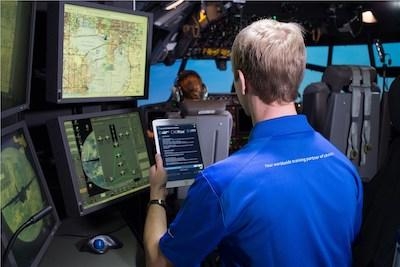Fri, Nov 30, 2018
Data-Driven Training System Provides Real-Time Insights And Standardized Evaluations (Rise) For Continuous Military Pilot Training Improvement
This week at at the Interservice/Industry Training, Simulation, and Education Conference (I/ITSEC), CAE announced the launch of CAE Rise for the defense market.

CAE Rise is a data-driven training system designed to enable defense and security organizations to deliver standardized training and give instructors a new approach to objectively assess pilot competencies using live data during training sessions. The system leverages big data analytics to reduce subjectivity in pilot assessment, allows instructors even greater focus on teaching, and helps create more efficient and continually improving training programs. CAE Rise is one of CAE’s latest digital innovations and has already been deployed for training CAE’s airline partners.
CAE conducted demonstrations each day during the show, with CAE Rise integrated on a T-6C simulator. The demonstrations show how CAE Rise gathers data during simulator training sessions, and then provides an instructor with real-time, objective assessments of student performance against pre-determined criteria for specific training tasks.
“CAE Rise is a prime example of CAE’s commitment to investing in the development of digital technologies to revolutionize pilot training,” said Gene Colabatistto, CAE’s Group President, Defense & Security. “The aviation industry – both military and civil – faces the long-term challenge of producing sufficient numbers of highly-qualified pilots to meet demand. CAE’s focus on aviation training and innovations such as CAE Rise will contribute to making pilot training more efficient, standardized and objective, which ultimately helps produce higher-quality and better prepared pilots.”
Some of the key features, capabilities and benefits of CAE Rise for military pilot training include:
- Developed on Microsoft Azure Government for cloud computing to meet government cybersecurity and compliance requirements;
- Facilitating student-centric learning by providing digital lesson plans, real-time feedback and ability to tailor training to each student;
- Improving instructor performance by facilitating student interaction and reducing administrative burden;
- Enabling training organization efficiencies such as maintaining electronic records, identifying performance gaps, and implementing closed-loop, adaptive training.
(Image provided with CAE news release)
More News
Pilot Applied Full Aft Stick And Nose-Up Trim, But The Airplane Remained On The Runway Analysis: The pilot reported that a preflight inspection and flight control checks revealed n>[...]
A Few Questions AND Answers To Help You Get MORE Out of ANN! 1) I forgot my password. How do I find it? 1) Easy... click here and give us your e-mail address--we'll send it to you >[...]
From 2022 (YouTube Edition): Before They’re All Gone... Humankind has been messing about in airplanes for almost 120-years. In that time, thousands of aircraft representing i>[...]
Advanced Air Mobility (AAM) A transportation system that transports people and property by air between two points in the NAS using aircraft with advanced technologies, including el>[...]
Aero Linx: MQ-1B Predator The MQ-1B Predator is an armed, multi-mission, medium-altitude, long-endurance remotely piloted aircraft that is employed primarily as an intelligence-col>[...]
 NTSB Final Report: Douglas A-4K
NTSB Final Report: Douglas A-4K ANN FAQ: Q&A 101
ANN FAQ: Q&A 101 Classic Aero-TV: PBY Catalina--From Wartime to Double Sunrise to the Long Sunset
Classic Aero-TV: PBY Catalina--From Wartime to Double Sunrise to the Long Sunset ANN's Daily Aero-Term (07.01.25): Advanced Air Mobility (AAM)
ANN's Daily Aero-Term (07.01.25): Advanced Air Mobility (AAM) ANN's Daily Aero-Linx (07.01.25)
ANN's Daily Aero-Linx (07.01.25)



